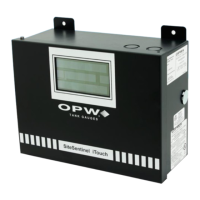Doc. No.: M1500 Rev. 5
Page 73 of 127
• 67733 Gross Point Road 900 Santa Fe Dr.
Doc. No.: M1500, Rev. 5
Page 73 of 127
67733 Gross Point Road 900 Santa Fe Dr.Doc. No.:
M1500, Rev. 5
Page 73 of 127
• 67733 Gross Point Road 900 Santa Fe Dr.
•
5. Use SiteConnect to program all alarms associated with the lower threshold to activate if the sensor
detects hydrocarbon liquid.
14.1.17 Testing the Float Sensor Portion of the Combo Sensor
Sensor Installed in a Normally Dry Well
1. Place the LOWER float in the UPPER position. Place the UPPER float in the LOWER position. This
should trigger an alarm in the Controller.
2. Place both the LOWER and UPPER floats in the UPPER position. This should trigger a “High-Level”
alarm in the Controller.
3. Return both floats to the LOWER position. Confirm that the alarm ends in the Controller.
Sensor Installed in a Normally WET Well
1. Place the LOWER float in the LOWER position. Place the UPPER float in the LOWER position. This
should trigger an alarm in the Controller.
2. Place the LOWER float in the UPPER position and move the UPPER float in the UPPER position. This
should trigger an alarm in the Controller.
3. Leave the LOWER float in the UPPER position and move the UPPER float to the LOWER position.
Confirm that the Controller is no longer in alarm.
If the Controller fails to register the alarm condition, check your programmed thresholds in the Controller.
Check the orientation of the floats as described on page 28.
Disconnecting the sensor should trigger an alarm and shorting the sensor should defeat an alarm. Check all
wiring and junction boxes to ensuring continuity without shorts.
14.1.18 Testing and Decontaminating the Hydrocarbon Portion of the Combo
Sensor
To prevent the possibility of explosion or fire, do not test the sensor in the
Hazardous Area.
Work in a well-ventilated area with no hot surfaces or open flames.
Do not use fuel to test the sensor!
If the SiteSentinel iTouch Controller fails to detect alarm conditions simulated here, also check that your
controller thresholds are correct.
• Testing the Hydrocarbon Liquid Sump Sensor. Immerse the polymer in mineral spirits for about 10
minutes. Remove the sensor and let it hang to air dry. After another 10 minutes any Controller alarms
or events associated with the hydrocarbon sensor should trigger. Disconnect this portion of the sensor
from the Controller – an immediate alarm should result. Short across these Controller positions – an
alarm should also occur. If the open lead and/or short lead test fail, check all wiring and junction boxes
for continuity.
• Cleaning the Hydrocarbon Liquid Sump Sensor. To clean the hydrocarbon contamination from the
sensor from testing or actual use, immerse the contaminated portion in denatured alcohol for one hour.
Then, flush the sensor with water to remove any residue. Leave the sensor to “settle” for another hour.
The sensor should return to nearly its original resistance, but it may be necessary to re-adjust the
Controller’s thresholds.

